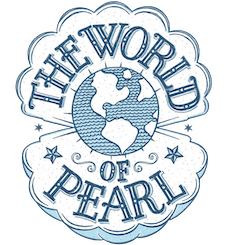The Pearl of A Queen is the pearl that launched America’s passion for natural, American pearls.
It all started in 1857 when David Howell, a shoemaker from Paterson, New Jersey went fishing for mussels in nearby Notch Creek and discovered several pearls. He was then joined by two local pearl hunters, Jacob and John Quackenbush. Jacob promptly discovered a 23.24 carat pink pearl, 15mm in diameter. Weeks later, on April 6, 1857, the Paterson, New Jersey Guardian reported “Quite an excitement has, for the past fortnight, existed in the upper part of this city owing to a sort of Pearl Mania.” Yes, Jacob went on to sell that large pink pearl to Tiffanie and Company for $1500. Imagine, at the time, most workers made $5 a week. This was a huge amount of money and the people of Paterson and Passaic County dropped everything to search local brooks and rivers for pearls!

So,what became of this 23 carat pearl? It was sold to a French dealer who then sold it to Empress Eugenie de Montijo, the wife of the French Emperor Napoleon III. And this is how it became known as the Pearl of A Queen. Some people also refer to it as “American Queen Pearl”.Of course, extraordinary pearls are sometimes referred to as Queen Pearls. Eugenie enjoyed her pearl for many years until one day she gave it away.

Eugenie donated many of her pearls and jewels to her dentist Dr. Thomas Evans. Yes, I know what you are thinking… He must have been one heck of a dentist! Well, there is a bit more to Dr. Evans. In 1870-1871, Napoleon III led France into the Franco-Prussian war, a war with the Germans. He was defeated and taken prisoner and Eugenie had no choice but to flee France. Dr. Evans facilitated her escape to England. As a thank-you, Eugenie gave many of her prized gems to Dr. Evans including this Queen Pearl, originally discovered in Paterson. Upon his death, the widowed, childless Evans donated the collection to the University of Pennsylvania dental school. Parts of Dr. Thomas Evans collection was then acquired by New York City’s Smithsonian Cooper-Hewitt, National Design Museum.
For many years, the fate of the Pearl of A Queen still remained a mystery. It was only after re-examination of the Cooper-Hewitt collection that the pearl was discovered in a snake topped stickpin. The pin was taken apart and the pearl matches the exact weight of the original pearl found in Paterson. Although the description of the pearl varies, it is universally agreed that this must be the famous Pearl of A Queen, Paterson pearl.
And what happened with the other residents of Paterson, N.J. who suddenly became eager to search for their own treasure? According to the Passaic County Historic Society, “within a short space of years, Passaic County and its entire surrounding area had been entirely divested of mussels—thus eliminating for all time the pearl industry. It was great fun while it lasted and many people were handsomely rewarded.” Some other residents did find their own pearls in these American Pearl mussels but certainly none compared to this Pearl of A Queen.
I am a modern day treasure hunter who travels the world for gorgeous pearls and amazing adventures. I own a pearl jewelry and jewelry repair business, ThePearlGirls.com, with a cute retail store in Athens, GA. I also have a Pearl Travel business and travel blog at TheWorldofPearl.com.




